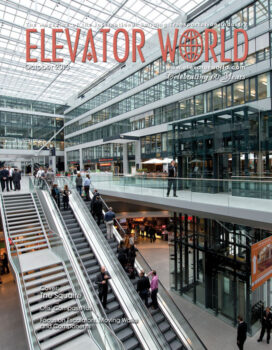Which Materials Will Be Used in the Escalators of the Future?
Oct 1, 2013
Millions of people use escalators every day. I wonder how many of them have questioned the type of material used to manufacture escalators and components. Looking at a car from the outside, one can see the body is made from metal(s). The tires are rubber, the windows are glass, etc. While riding them, one may notice being surrounded by components and subassemblies made from light and heavy materials such as leather, rubbers and plastics.
If people examine a train or airplane from inside and out, they can conclude that they, too, are made from different types of materials, such as metals, composites, plastics, rubbers and ceramics. As a transportation system, escalators should have the same diversity of materials used for their manufacture. To an escalator specialist, the answer to such a design might be easy, but to a layman, it might be difficult to understand. This article will try to provide a general understanding of what goes inside one of the most important means of transportation from a materials perspective.
There are two types of escalators: light and heavy duty. Their design specifications differ, because of loading and operational conditions. Heavy-duty escalators are higher in rise (more than 10 m), transport a higher volume of passengers and work for long periods each day (more than 20 hr.). Regardless of the type of escalator, the operation and mechanical principles remain the same: similar to a bicycle, which has sprockets connected by a chain. The torque is applied on one sprocket; the chain transfers the torque to the second sprocket to be converted to linear speed.
An escalator consists of two shafts: a top and idler shaft. Each shaft has two sprockets, one at each end/side of the shaft. The sprockets are connected by a chain at each side. The top shaft has another sprocket, which takes torque from a chain connected to a motor. The top shaft also has an additional smaller sprocket, which drives the handrail system. Steps are mounted on the chains of the two main shafts (top and idler shafts), and the sprockets form the step band. The step band is a closed loop, which goes around the two shafts, and along the landings and incline. The steps run on tracks, which are laid along the landings and incline in the main and return sides. The steps and chains have wheels to help ease the movement of the steps and chains on the tracks. The handrail system is used to drive the handrail belts to a speed equal to that of the step band. The handrail belt is used by passengers to support their weight and/or increase their stability when standing on the step band.
| Components and Subassemblies | Materials |
| Top and idler shafts with sprockets | Cast iron, plain carbon steel, and manganese or chromium steel |
| Steps | Plain carbon steel, cast steel, aluminum, plastics and rubbers |
| Chains | High-strength steel and nitrided steel |
| Tracks | Plain carbon steel |
| Carriage | Plain carbon steel |
| Trusses, balustrades, decking and skirts | Plain carbon steel (coated or galvanized) |
| Controllers | Plain carbon steel, ceramics and plastics |
Table 1 lists the aforementioned parts and subassemblies, and the materials from which they are made. The top and idler shafts, with their sprockets, tend to be made from cast iron, or plain carbon, manganese or chromium steel. Heat treatments might be used on the materials of the sprockets to obtain specific mechanical properties.
The steps are made of carbon steel. Some parts of the steps are made of cast steel. Steps have also been made of aluminum and are often used in light-duty escalators. The wheels of the steps and chains are made from cast steel or aluminum. The wheels have tires, which are made of rubber or plastic compositions. The chains of the step bands are subjected to tension by the carriage, which is manufactured mainly from parts made of plain carbon steel.
The entire escalator is enveloped and supported by trusses. The top of the escalator is covered with a balustrade, decking and skirting, all of which are often manufactured of plain carbon steel, which can be coasted or galvanized. The controller of an escalator has electronics, which are made from ceramics with supports manufactured from metals or plastics.
It is interesting to discover that a transportation vehicle like an escalator does not have the same level of material diversity that other modern means of transportation have. Up to 95% of the components of heavy-duty escalators are made from some sort of steel. The harsh operational conditions could be the reason many manufacturers use such durable materials. However, from a mechanical or properties perspective, other metals can also match the durability steel provides. Costs and ease of availability are other reasons steel might often be used. In addition, fire regulations pose restrictions that might hinder designers’ and manufacturers’ ability to explore such materials as plastics. A heavy-duty escalator can have up to 50 main assemblies (10,000 components), none of which use ceramics or plastic as a common material.
One approach has been in changing the materials of the escalator steps from steel to aluminum. Although this change has been established in the light-duty escalators sector, greater efforts are needed to change the culture in the heavy-duty escalators sector. A similar change needs to be applied to other subassemblies to shift dependency from a single material type to a variety of material types. This could contribute to sustaining raw materials by creating a balance between good escalator designs and the resources available with which to manufacture them. However, the industry will need to plan and strategize to engage this shift.
Get more of Elevator World. Sign up for our free e-newsletter.









